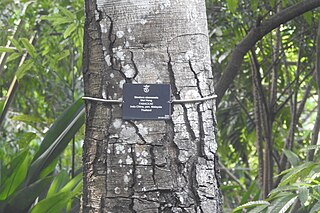
Stung Treng is a province of Cambodia in the northeast. It borders the provinces of Ratanakiri to the east, Mondulkiri and Kratié to the south and Kampong Thom and Preah Vihear to the west. Its northern boundary is Cambodia's international border with Laos. The Mekong River bisects the province. The province is mostly covered by forest, but logging and fishing put high pressure on the forest and fishery reserves.
Articles related to Cambodia and Cambodian culture include:
Kuy, also known as Kui, Suay or Kuay, is a Katuic language, part of the larger Austroasiatic family spoken by the Kuy people of Southeast Asia.
The National Television of Cambodia is the national television station of Cambodia. It is owned and operated by the government of Cambodia in Phnom Penh together with the national radio station, National Radio of Cambodia. TVK is member of the Asia-Pacific Broadcasting Union (ABU).

Sindora siamensis is a species of tree in the subfamily Detarioideae of the family Fabaceae. It has an accepted infraspecific, the variety S. siamensis var. maritima (Pierre) K.Larsen & S.S.Larsen. See taxon box to the right below, and below for details on the variety maritima. The nominate species is found in many countries in tropical Asia. Like several other species in the genus Sindora, its wood is considered valuable; the least concern conservation status may reflect efforts to replant this species, but mortality rates are high. As well as the wood, the plant provides raw material for chemical products, food and drink, and domestic utensils.

The Kuy are an indigenous ethnic group of mainland Southeast Asia. The native lands of the Kuy range from the southern Khorat Plateau in northeast Thailand east to the banks of the Mekong River in southern Laos and south to north central Cambodia. The Kuy are an ethnic minority in all three countries, where they live as "hill tribes" or Montagnards. Their language is classified as a Katuic language of the Mon-Khmer language family. The Thais, Lao, and Khmer traditionally recognize the Kuy as the aboriginal inhabitants of the region. The word kuy in the Kuy language means "people" or "human being"; alternate English spellings include Kui, Kuoy and Kuay, while forms similar to "Suay" or "Suei" are derived from the Thai/Lao exonyms meaning "those who pay tribute". The Kuy are known as skilled mahouts, or elephant trainers, and many Kuy villages are employed in finding, taming, and selling elephants.
Ziziphus cambodiana is a deciduous thorny shrub, or vine, some 2–6 m tall, found growing in secondary undergrowth in Cambodia, Laos and Vietnam, and northern Thailand.

A small tree with tortuous twigs, Dillenia pentagyna is a member of the family Dilleniaceae, and is found from Sulawesi to South-Central China to India and Sri Lanka. Material from the tree has some minor uses.

Antidesma japonicum is a shrub in the family Phyllanthaceae. It is found in Southeast Asia, China and Japan. It provides food and fuel. A. japonicum has two accepted varieties: the nominate variety, A. japonicum var. japonicum; and the robustius variety, A. japonicum var. robustius.
Aporosa ficifolia is a species of shrub in the family Phyllanthaceae. It grows 2-8m tall, it has a restricted habitat, growing in lowland open or pine forests up to 700m elevation.
Aporosa planchoniana is a species of shrub in the family Phyllanthaceae.
Dendrolobium baccatum is a species of flowering plants in the Fabaceae family. A shrub, it occurs in Mainland Southeast Asia. People use it for food and fuel.
Elaeocarpus thorelii is a tree in the family Elaeocarpaceae, endemic to Cambodia, and used for its wood.
Gluta cambodiana is a shrub/small tree in the family Anacardiaceae. It occurs in parts of Mainland Southeast Asia. Its wood is used for pickets and fuel.
Memecylon caeruleum is a shrub or tree species in the Melastomataceae family. It is found from New Guinea, west through Southeast Asia to Tibet, Zhōngguó/China. It has become an invasive weed in the Seychelles. It has some local use for wood and food.
Pantadenia adenanthera is a shrub in the Euphorbiaceae family. It is found in parts of Southeast Asia. The species is used for its wood and edible fruit.
Stixis obtusifolia is a shrub or liana in the Resedaceae family. It is found in parts of Southeast Asia. The wood is used as fuel, the leaves as a tea.
Strychnos nux-blanda is a shrub or small tree in the Loganiaceae family. It is native to Southeast Asia and Assam. The wood is used as fuel; seeds are toxic, but used in folk-medicine. It is one of the plants featured in the garden of King Narai (1633–88) at Lopburi, Thailand.

Xanthophyllum lanceatum is a tree in the Polygalaceae family. It grows across Southeast Asia from Sumatera to Bangladesh. The leaves are used as a hops-substitute in beer making and the wood as fuel. Fish in the Mekong regularly eat the fruit, flowers and leaves.





